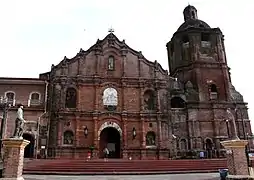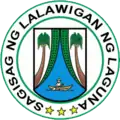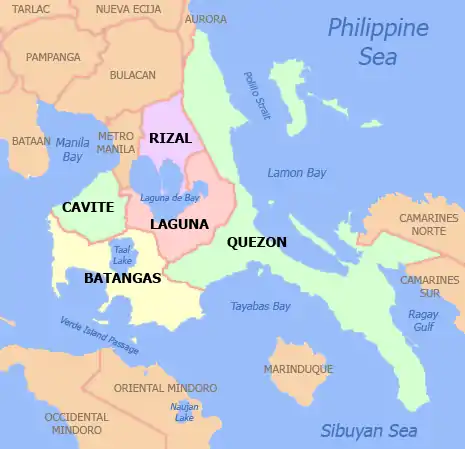Liliw
Liliw, officially the Municipality of Liliw (Tagalog: Bayan ng Liliw), is a 4th class municipality in the province of Laguna, Philippines. According to the 2015 census, it has a population of 36,582 people. [4]
Liliw | |
|---|---|
| Municipality of Liliw | |
 Downtown area | |
 Seal | |
| Nickname(s): Flip-flops Capital of the Philippines[1] | |
| Motto(s): "Baleng Ganda, Baleng Saya" | |
 Map of Laguna with Liliw highlighted | |
OpenStreetMap 
| |
.svg.png.webp) Liliw Location within the Philippines | |
| Coordinates: 14°08′N 121°26′E | |
| Country | |
| Region | Calabarzon (Region IV-A) |
| Province | Laguna |
| District | 3rd District |
| Founded | August 29, 1571 |
| Barangays | 33 (see Barangays) |
| Government | |
| • Type | Sangguniang Bayan |
| • Mayor | Ericson J. Sulibit |
| • Vice Mayor | Arnold A. Montesines |
| • Representative | Marisol A. Sampelo |
| • Electorate | 24,036 voters (2019) |
| Area | |
| • Total | 39.10 km2 (15.10 sq mi) |
| Elevation | 449 m (1,473 ft) |
| Population | |
| • Total | 36,582 |
| • Density | 940/km2 (2,400/sq mi) |
| • Households | 8,990 |
| Economy | |
| • Income class | 4th municipal income class |
| • Poverty incidence | 3.92% (2015)[5] |
| • Revenue | ₱86,346,265.50 (2016) |
| Time zone | UTC+8 (PST) |
| ZIP code | 4004 |
| PSGC | |
| IDD : area code | +63 (0)49 |
| Climate type | tropical monsoon climate |
| Native languages | Tagalog |
| Website | www |
It is one of the highland towns forming the southern extremity of Laguna. It is situated at the foot of Mt. Banahaw.
Liliw has a total land area of 3,910 hectares (9,700 acres). [3] It is bounded on the north-west by Santa Cruz; north-east by Magdalena; on the east by Majayjay; on the west by Nagcarlan; and on the south by Dolores, Quezon.
Liliw is perhaps best known for its cold water spring resorts, native homemade sweets and a sizeable shoe industry that rivals that of Marikina City. The town is also known for its baroque church and its Liliw-style houses. The local government is currently undertaking means to conserve its cultural heritage sites and has proposed to enact a legislation that would mandate the usage of the Liliwstyle architecture as the only means of construction and re-construction in the town. If the ordinance passes, Liliw will have a greater chance to become a heritage town, and further support from the National Commission for Culture and the Arts.
History
Founded in 1571 by Gat Tayaw, the small town of Liliw is nestled at the foot of Mount Banahaw, 17 kilometres (11 mi) away from Santa Cruz, Laguna's capital.
According to a story, Liliw got its name from a bird. It was said that Gat Tayaw and his followers decided to erect a bamboo pole and to name the town after the bird that would first alight at the top of the pole within four days. A crow, however, was the first bird to alight on the pole. A crow was considered bad and so Gat Tayaw and his men moved south and erected another bamboo pole. A beautiful bird alighted on the pole and sang, "Liw, Liw, Liw". Thus the town became Liliw.
Throughout the Spanish regime, the name Liliw was used. When the Americans came, it became Lilio since the Americans found it easier to pronounce it than Liliw. However, on June 11, 1965, the municipal council passed Resolution No. 38-S-65 which declared Liliw as the official name and spelling of the town. This was to avoid confusion in pronouncing and spelling the name of the town.
Barangays
Liliw is politically subdivided into 33 barangays. [3]
- Bagong Anyo (Poblacion)
- Bayate
- Bongkol
- Bubukal
- Cabuyew
- Calumpang
- Culoy
- Dagatan
- Daniw
- Dita
- Ibabang Palina
- Ibabang San Roque
- Ibabang Sungi
- Ibabang Taykin
- Ilayang Palina
- Ilayang San Roque
- Ilayang Sungi
- Ilayang Taykin
- Kanlurang Bukal
- Laguan
- Luquin
- Malabo-Kalantukan
- Masikap (Poblacion)
- Maslun (Poblacion)
- Mojon
- Novaliches
- Oples
- Pag-asa (Poblacion)
- Palayan
- Rizal (Poblacion)
- San Isidro
- Silangang Bukal
- Tuy-Baanan
Climate
| Climate data for Liliw, Laguna | |||||||||||||
|---|---|---|---|---|---|---|---|---|---|---|---|---|---|
| Month | Jan | Feb | Mar | Apr | May | Jun | Jul | Aug | Sep | Oct | Nov | Dec | Year |
| Average high °C (°F) | 25 (77) |
27 (81) |
28 (82) |
30 (86) |
30 (86) |
29 (84) |
28 (82) |
28 (82) |
27 (81) |
27 (81) |
27 (81) |
25 (77) |
28 (82) |
| Average low °C (°F) | 19 (66) |
18 (64) |
19 (66) |
21 (70) |
22 (72) |
23 (73) |
22 (72) |
22 (72) |
22 (72) |
21 (70) |
21 (70) |
20 (68) |
21 (70) |
| Average precipitation mm (inches) | 52 (2.0) |
35 (1.4) |
27 (1.1) |
27 (1.1) |
82 (3.2) |
124 (4.9) |
163 (6.4) |
144 (5.7) |
145 (5.7) |
141 (5.6) |
100 (3.9) |
102 (4.0) |
1,142 (45) |
| Average rainy days | 12.0 | 8.1 | 8.8 | 9.7 | 17.9 | 22.6 | 26.2 | 24.5 | 24.6 | 22.0 | 16.7 | 14.9 | 208 |
| Source: Meteoblue [6] | |||||||||||||
Demographics
| Year | Pop. | ±% p.a. |
|---|---|---|
| 1903 | 4,669 | — |
| 1918 | 6,306 | +2.02% |
| 1939 | 7,588 | +0.89% |
| 1948 | 7,977 | +0.56% |
| 1960 | 11,064 | +2.76% |
| 1970 | 14,638 | +2.84% |
| 1975 | 15,907 | +1.68% |
| 1980 | 17,436 | +1.85% |
| 1990 | 21,911 | +2.31% |
| 1995 | 24,434 | +2.06% |
| 2000 | 27,537 | +2.60% |
| 2007 | 32,727 | +2.41% |
| 2010 | 33,851 | +1.24% |
| 2015 | 36,582 | +1.49% |
| Source: Philippine Statistics Authority [4] [7] [8][9] | ||
In the 2015 census, the population of Liliw was 36,582 people, [4] with a density of 940 inhabitants per square kilometre or 2,400 inhabitants per square mile.
Transportation
Tricycles and jeepneys are popular modes of transportation in Liliw. Buses are available to Santa Cruz, Calamba, and Metro Manila.
How to get there Liliw is 110 kilometers from Manila via Santa Cruz and 105 kilometers via San Pablo.
For those taking public transport, there are buses in Cubao in Quezon City, Buendia in Makati/Pasay, and Alabang in Muntinlupa going to either Santa Cruz or San Pablo. Travel time from Manila is about two hours. Upon arriving in either Santa Cruz or San Pablo, take a jeepney going to Liliw.
Those bringing private vehicles have several options. The trip to Liliw can be combined with Nagcarlan and Majayjay using the San Pablo route or with Pagsanjan and Lake Caliraya using the Santa Cruz route. If it’s summer, avoid the Santa Cruz route as traffic at the Pansol area can become horrible.
The route via San Pablo starts in Manila, enters South Luzon Expressway and exits from Santo Tomas. From there, continue driving to Alaminos town, then enter city of San Pablo, turn left to Rizal, continue driving via Nagcarlan before finally arriving in Liliw.
Liliw is known for its baroque style church whose façade is made of striking red bricks. Known as St. John the Baptist church, its first church was built in wood in 1620. The stronger stone church was built from 1643 to 1646. The present church patio has been developed to promote Catholic teachings. Standing in front of the church are several elevated statues of different saints that are patrons of each of the town’s barangays (villages).
Standing next to the municipal hall is the statue of Gat Tayaw. On Gat Tayaw and P. Burgos streets still stand the ancestral houses of many of Liliw’s prominent families who got rich during the American time from agricultural products like copra, lanzones, banana, and vegetables like tomatoes and mustasa.
Liliw also has many natural attractions like the Kilangin Falls and the colds springs of Batis ng Liliw and Liliw Resort.
But the town’s main attraction is its growing footwear industry. It started in 1931 when Casiano Pisuena became interested in making slippers. His first prototype was made from coconut husk and rubber from tire interiors. He soon became successful and many residents of Liliw followed suit. At present there are about 50 stores selling footwear in Liliw. The regular slippers are still the most popular, but many stores are now selling shoes, handbags and other leather goods. Most stores still carry the three-for-P100 slippers. The annual Tsinelas Festival is celebrated every end of April.
Gallery
 Saint John the Baptist Parish Church
Saint John the Baptist Parish Church Liliw town hall
Liliw town hall Poblacion
Poblacion Tsinelas Capital of the Philippines
Tsinelas Capital of the Philippines
References
- Manila Shopper - Footwear Shopping in Liliw
- Municipality of Liliw | (DILG)
- "Province: Laguna". PSGC Interactive. Quezon City, Philippines: Philippine Statistics Authority. Retrieved 12 November 2016.
- Census of Population (2015). "Region IV-A (Calabarzon)". Total Population by Province, City, Municipality and Barangay. PSA. Retrieved 20 June 2016.
- "PSA releases the 2015 Municipal and City Level Poverty Estimates". Quezon City, Philippines. Retrieved 1 January 2020.
- "Liliw: Average Temperatures and Rainfall". Meteoblue. Retrieved 11 May 2020.
- Census of Population and Housing (2010). "Region IV-A (Calabarzon)". Total Population by Province, City, Municipality and Barangay. NSO. Retrieved 29 June 2016.
- Censuses of Population (1903–2007). "Region IV-A (Calabarzon)". Table 1. Population Enumerated in Various Censuses by Province/Highly Urbanized City: 1903 to 2007. NSO.
- "Province of Laguna". Municipality Population Data. Local Water Utilities Administration Research Division. Retrieved 17 December 2016.
External links
| Wikimedia Commons has media related to Liliw, Laguna. |

